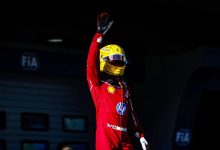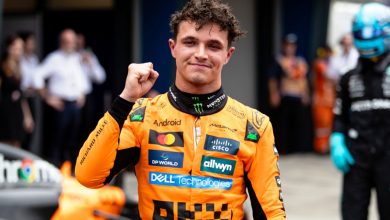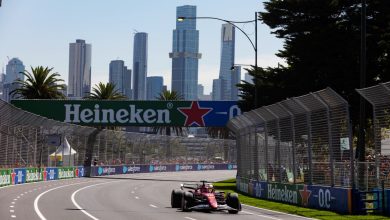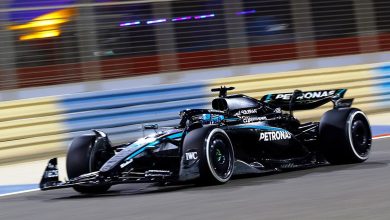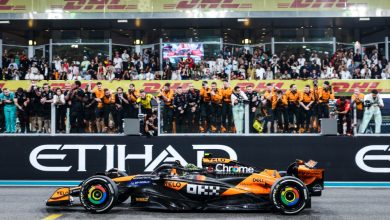All about Mercedes AMG Petronas F1 team ahead of the Hungarian Grand Prix
Budapest, 23 July 2014: Round 11 of the 2014 Formula One World Championship brings us to Budapest for the Hungarian Grand Prix, held at the Hungaroring.
The Mercedes AMG Petronas is sitting pretty with a gigantic lead of 178 points in the Constructor’s Championship with a kitty of 366 while teammates Nico Rosberg and Lewis Hamilton are on a close fight. Rosberg is leading the battle with 190 points from the 10 races at the mid-way point in the 19-race season. He won four times and finished 2nd five times, with his only retirement at the British GP to lead his teammate by 14 points in the Driver’s Championship. The German got married on July 11 and is in seventh heaven. He signed a new-multi-year contract with Mercedes and extended the celebrations of German World Cup victory with a win at home in the German Grand Prix last week.
British driver Lewis Hamilton on the other hand has 176 points and is ahead of third-placed Daniel Ricciardo (106) of Red Bull by 70 points. He has one more victory than Rosberg, at five wins, but he failed to finish twice; at the season opener in Australia and then at the Canadian Grand Prix. He came second twice and was third at the German Grand Prix last week as Valtteri Bottas stuck on to take his Williams to a second place on the podium for the second successive week.
But the former World Champion is eagerly waiting to strike back. He is full of praise for the team and feels that the team has done a great job in putting both the cars on the podium once again.
Lewis Hamilton: “I was very proud that we could put both cars on the podium for Mercedes-Benz in Germany in front of all the Mercedes employees there last weekend. From a personal point of view, I couldn’t be too ecstatic about the race because it was a tough weekend for me and ultimately I lost more points to Nico in the Championship battle.
“But I had great fun out there and did as good a job as I could. To get the car from right at the back to the podium was quite an achievement for everyone involved and I’m grateful that we could limit the damage after qualifying. The Hungarian Grand Prix is always a special one for me, with four pole positions and four wins from my seven races there so far – including my first victory for Mercedes last season.
“I don’t really have any secrets there – I’ve just been very fortunate over the years and it’s a circuit I really enjoy. It’s one where you can really attack, which works for an attacking driver like myself, so perhaps it suits my driving style a little bit more than some others. I’ve always had great support there from the fans too, so I’m looking forward to it. I’m doing absolutely everything I can to get back on level terms with Nico in the title battle – I can’t focus more or work harder than I am doing right now. This Championship is proving a big challenge for me but that’s how I love it – and I wouldn’t have it any other way.
German Nico Rosberg is flying and looks forward to the Hungarian Grand Prix with confidence:
“It was an amazing feeling to take a home victory for myself and Mercedes-Benz at Hockenheim. That race and Monaco are the ones I really want to win, so I came into the weekend hoping for a good result and it worked out perfectly. My Silver Arrow was so dominant and I have to thank the team for this fantastic car. So many positive things have been happening for me in the last few weeks.
“Getting married was definitely the best feeling, then with the new contract, the World Cup for Germany and the weekend at Hockenheim. It’s been a very special time for me. Now we head to Hungary, which is always a really fun weekend in a lot of different ways.
“Budapest is a really cool city, with a lot of nice things to do in the evening with all the restaurants on the river. I often have friends come to this race as they really enjoy the place – although, of course, while they’re out partying on the Saturday night, I’ll focusing and preparing for the race! We’ve had some great after-race parties on the Sunday night in Hungary before, as it’s the last one before the summer break. Hopefully we can give everyone back at the factories and here at the circuit something to really cheer about as a reward for all their hard work before they go on holiday!
Toto Wolff, Head of Mercedes-Benz Motorsport, is also on a high:
“Our performance at the last race in Germany was very satisfying indeed. So many of our board members, colleagues and friends from Stuttgart were there in Hockenheim for the weekend so the pressure was on. We’ve performed well at the other big races for the team in Malaysia and Britain, but this was the pinnacle for us as a home race.
“As our thoughts now turn swiftly to the next race in Hungary, it’s important to recognise the hard work put in by everyone at our factories in Brackley and Brixworth. It’s a tight turnaround between the two races and this will be the final trip before the summer break, so we are pushing flat out to make sure we wrap up the first part of the season on a high. It has been a very busy year so far and another strong result would be the right reward for everyone involved before taking a well-earned rest. We had a spectacular race in Hockenheim and Budapest also has real potential to deliver an exciting Sunday afternoon, although overtaking is much more challenging there. the Hungaroring has always seen fantastic levels of support and we are looking forward to putting on a good show for the fans.
Paddy Lowe, Executive Director (Technical)
Germany proved to be a busy weekend for the team from start to finish – both in the garage and off track as the home race for Mercedes-Benz. The big talking point going into the weekend was, of course, the demise of FRIC. Much was made of its potential impact on the relative performance of the teams, but as we saw from the first sessions on Friday this did not come to fruition. Lewis’ incident during qualifying came as a big shock. The damage to the car left us with some difficult decisions to make and, in the end, changes to the gearbox meant a 5-place penalty dropped Lewis even further down the grid. Lewis then produced a superb recovery drive from the back of the grid to claim a fine podium finish. Nico, meanwhile, built on a strong qualifying position with a perfectly judged race performance to take a well-earned home win. We now move on to Hungary, which will be another interesting challenge. It’s usually very hot in Budapest, which will be a consideration in terms of car setup. Overtaking is also notoriously tough around the Hungaroring circuit – with a high emphasis placed on a good qualifying result. Lewis has a fantastic record at this particular venue, with four pole positions and four wins from his seven races here. Nico, by contrast, has had a tough time in Hungary in previous years. However, judging by his performance in Germany last weekend we should be set for another fascinating battle between the two drivers. As a team, we will approach this race as we would any other as we look to cap off a strong start to the season with an equally strong result heading into the summer break.
Hungaroring: The Inside Line
Lewis
The weather is usually fantastic in Hungary and the circuit is quite an old-school layout, so it’s got plenty of great characteristics. It definitely suits my ‘aggressive’ driving style – as I think a lot of people like to call it. You start the lap with DRS across the pit straight – which is actually quite short compared to a lot of other tracks. You’re then late on the brakes into the right-hander of Turn One, ideally hitting the apex right in the middle, then hard on the power and opening the DRS once again on exit.
You have to brake really deep into the left-handed Turn Two and really hug the apex, with a good line crucial to allow you to go flat-out through the right-hander at Turn Three – using all of the kerb on exit. It’s really hard to see the apex at Turn Four, which arrives very quickly and is another really fast corner. Turn Five is then a bit slower – heading back to the right and with a bumpy surface on exit which can easily lead to oversteer moments.
A good run through the Turn Six / Seven chicane needs you to take all the available kerb through the first part and then get hard on the power out of the second – leading into a really nice left-right-left-right sequence at Turns Eight, Nine, 10 and 11. You have to be really patient through here, as a good rhythm is important.
Finally, you’re into the last sector – beginning with Turn 12. There is a lot of grip on the way into this corner, which requires minimum kerb contact on entry but maximum on exit. You need patience once more through Turn 13, which you almost have to make into a ‘vee’ for the best line, and again through the final corner, Turn 14, which is crucial for a good run down the straight.
Nico
The Hungaroring is quite a unique circuit as it is very small and narrow – almost like a street circuit, but in the form of a permanent race track. It’s really twisty, with very few straights and the left-right-left-right nature meaning you barely get any time to relax. You’re always in action, so it’s very tough on the driver. Luckily, I enjoy those sorts of challenges as it’s where you can really make a difference as a driver. You also have to really nail some of the kerbs to get the line just right, otherwise you’ll lose the rhythm and lose a lot of speed.
Budapest as a venue is also quite tough on the driver physically, as it can get very hot. Again, the lack of straights also mean you have very little time to take a breather and get some cool air rushing around you. You’re always tensed up in the cockpit, fighting all the corners, so it is pretty demanding from that perspective.
The key corners around the circuit are Turn One, which is the best place to overtake after the longest DRS straight on the track, and then I would say Turn Five. This is around the back of the circuit and comes after the very fast Turn Four – sweeping up and right for quite a long time. It’s easy to get this one wrong and you really have to hook your inside tyre into the little ditch on the inside of the apex to make it work best, so it’s tricky but a lot of fun.
On the Pit Wall
Circuit Layout
The Hungaroring is a highly technical circuit which requires a very different driving style – beyond the standard procedure of taking a late apexes and managing traction on exit. Through many of the corners, the fastest line may require drivers to hold minimum speed – a technique which suits some more than others. This will also play to the strengths of some cars more than others, with those that can sustain extended periods of lateral loading coming to the fore. It’s a track at which getting everything spot on is extremely difficult, with rhythm playing an important role – much as it does in Monaco, although not to the same extent.
Overtaking
Overtaking is notoriously difficult at the Hungaroring. The start / finish straight is not particularly long, while the second DRS zone between Turns One and Two is more of a kink – offering equally scare opportunities for passing manoeuvres. Qualifying is therefore crucial, with races often defined by the starting grid. That said, Lewis pulled off two fantastic overtaking manoeuvres in 2013 to take an impressive victory. There were done through corners where the opposition would never have expected to be passed – proving that with the right level of bravery, it can be done…
Safety Cars
Safety car probability is surprising low here given the narrow nature of the circuit. There are, however, very few gravel run-off areas, with tarmac preferred through most corners – which is undoubtedly a contributing factor.
Tyres
Budapest has historically seen the softest allocation of tyre compounds, the soft and Supersoft, however Pirelli have remained consistent with their choice of Soft and Medium, as 2013. This is a contrast to Germany, where we had the more aggressive choice of the Supersoft and Soft. The Hungaroring track surface is not overly abrasive, with one stop strategies having been deployed on occasion in the past. However, temperatures frequently reach levels sufficient to introduce three stop strategies – which have been a far more frequent occurrence.
Climate
There have been wet sessions every now and then during Hungarian Grands Prix weekends, but these are few and far between. 2011 saw a wet race and P2 was damp in 2012, but 2013 was a completely dry event. When it does rain in Budapest it rains very heavily indeed, but generally speaking the weather is relatively easy predict. It lies at the upper end of the range in terms of heat, with temperatures rising as high as 45 degrees – similar to the peak levels seen in Austria two races ago.
Double-header
Combining with Germany to form the first pair of back-to-back races since Malaysia and Bahrain way back in March / April, Budapest throws the teams back into a situation where preparation time is scarce. Whereas there has been plenty of time to prepare in advance of the more recent races, some resource has also been put into preparations for both Hockenheim and Budapest with the truncated timescale in mind – the priority being to ensure that data is not lacking by the time the teams arrive at the second event.
Anniversaries
Mercedes-Benz Heritage
21 / 22 July 1934 – 80 Years Ago:
In the ‘Kilometres Across Germany’ endurance event, Mercedes-Benz drivers claim a total of 26 gold, three silver and three bronze medals in the individual and team rankings. The 1.5-litre Sports Saloon, the chassis of which forms the basis for the 150 Sports Roadster presented at the start of 1935, has its first competitive outing.
25/26 July 1964 – 50 Years Ago:
Robert Crevits and Gustave Gosselin drive a Mercedes-Benz 300 SE to victory in the 24-hour race at Spa-Francorchamps, Belgium. The Belgian team sets an average speed of 164.875 km/h.
On-Track
28 July 2013 – One Year Ago:
Lewis Hamilton takes his first victory for MERCEDES AMG PETRONAS from pole position at the Hungaroring circuit.
Spotlight
120 Years Ago – The First Motor Race
On 22 July 1894, just eight years after the automobile’s invention, a ground-breaking city-to-city motoring competition entitled ‘Le Petit Journal Concours des Voitures sans Chevaux’ (or ‘Le Petit Journal Competition for Horseless Carriages’) would mark the very first foray into motorsport for two great marques that later re-wrote motorsport history: Daimler and Benz.
Held in France – at the time considered the most advanced motorised nation – the event was organised by national newspaper ‘Le Petit Journal’ to boost circulation and stimulate interest in motoring. Despite organisers stopping short of classing the event as a race, this 127 km test of pioneering machinery is widely regarded as the world’s first competitive motor race: offering prizes to the top finishers utilising eligible machinery (defined as not requiring a travelling mechanic or technical assistant such as an engine stoker). Although earlier competitions had been held for automobiles powered by steam, the 1894 event was the first to attract a full field of vehicles; thereby acquiring its prestigious standing in motoring history.
The race itself was preceded by four days of vehicle exhibition and qualifying events, comprising interwoven routes staged around the city of Paris to determine worthy entrants for the main event. Over 100 entries were submitted ranging from established manufacturers such as Peugeot to amateur enthusiasts, with 21 vehicles eventually taking to the start line: 13 of which were powered by internal combustion engines. With both Daimler and Benz represented, the event was to prove a landmark occasion in the history of both marques.
While the sole Benz entry was classified in the results – placing 14th at the hands of Emile Roger – it was a Panhard-Levassor which claimed equal first prize, powered by a twin cylinder, 30-degree vee petrol engine produced under licence from Gottlieb Daimler. Although the car was not the first to cross the finish line, it shared the ‘5,000 francs du Petit Journal’ with the Peugeot brothers on the basis of the vehicles being those which came “closest to the ideal” and were “easy to use”.
It was from these humble beginnings – a seven-hour journey averaging speeds of marginally less than 20 km/h – that the success story of Mercedes-Benz in motorsport finds its roots, as both Daimler and Benz went on to play leading roles in the formative years of auto racing history from the late 1800s into the early 1900s.
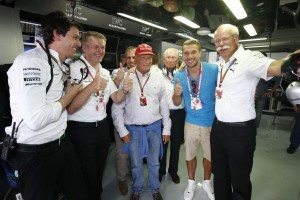
eom/Mercedes AMG Petronas release with inputs from INDIAinF1 Spl correspondent



